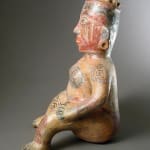Galo Polychrome Seated Female Figure, 500 CE - 1000 CE
Terracotta
16.5
PF.3548
Further images
This seated female figure comes from the Guanacaste-Nicoya polychrome tradition, the galo polychrome style. Its mirror-bright burnished surfaces are technically unsurpassed by any Pre-Columbian pottery, and yellows, reds, oranges, creams,...
This seated female figure comes from the Guanacaste-Nicoya polychrome tradition, the galo polychrome style. Its mirror-bright burnished surfaces are technically unsurpassed by any Pre-Columbian pottery, and yellows, reds, oranges, creams, maroons, and blacks of the polychrome decorations are impressively vivid. Among such sculptures are the full human figures with elaborate representations of tattoos or body paint. Such brilliant polychrome tradition represent an important social dimension; when the northern trade network that brought jade, slate-backed pyrite mirrors, foreign ceramics, and other luxury goods, the Nicoyans responded by producing their own special purpose pottery. Inspired by northern models, it also incorporated local and southern elements, forming a dazzling hybrid style that was traded around Central America and southern Meso-America in the centuries to come. Elaborately decorated with colors and patterns, this sculpted female sits proudly, like a dignified noble woman or a priestess. A fine example of galo polychrome figures, she provides a wealth of ethnographic detail because of the realistic style. Her headdress, black-patterned headband, wrist and ankle cuffs, earspools, and body painting or tattooing are all vividly shown. Elaborate patterns on her breasts emphasize her voluptuous feminine beauty, and the symbolic mark in the middle of her chest possibly indicate sacrificial ritual, an important religious practice in Ancient Costa Rica. With her face held up straight, this woman appears regal and goddess-like, demanding our attention with her physical presence.
Literature
V16









